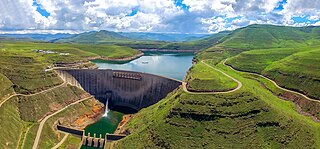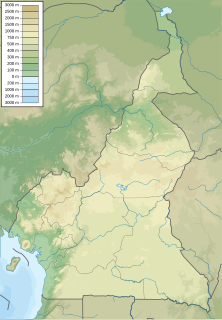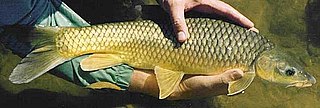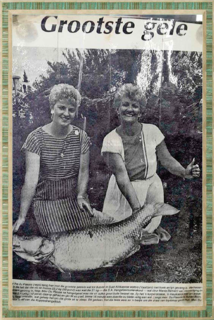
The ǂNūǃarib (Senqu) "Black River", IGqili, or under the colonial name, Orange River, is the longest river in Lesotho and the Orange River Basin extends extensively into South Africa, Namibia and Botswana to the north. It rises in the Drakensberg mountains in Lesotho, flowing westwards through South Africa to the Atlantic Ocean. The river forms part of the international borders between South Africa and Namibia and between South Africa and Lesotho, as well as several provincial borders within South Africa. Except for Upington, it does not pass through any major cities. The Orange River plays an important role in the South African economy by providing water for irrigation and hydroelectric power. The river was named the Orange River in honour of the Dutch ruling family, the House of Orange, by the Dutch explorer Robert Jacob Gordon. Other names include simply the word for river, in Khoekhoegowab orthography written as !Garib, which is rendered in Afrikaans as Gariep River with the intrusion of a velar fricative in place of the alveolar click, Groote River or Senqu River, derived from ǂNū "Black".

Hydroelectricity is electricity produced from hydropower. In 2015, hydropower generated 16.6% of the world's total electricity and 70% of all renewable electricity, and was expected to increase by about 3.1% each year for the next 25 years.

The Katse Dam, a concrete arch dam on the Malibamat'so River in Lesotho, is Africa's second largest double-curvature arch dam.. The dam is part of the Lesotho Highlands Water Project, which will eventually include five large dams in remote rural areas. The dam is just below the confluence of the Bokong River, which forms the western arm of the Katse reservoir.

The Lesotho Highlands Water Project (LHWP) is an ongoing water supply project with a hydropower component, developed in partnership between the governments of Lesotho and South Africa. It comprises a system of several large dams and tunnels throughout Lesotho and delivers water to the Vaal River System in South Africa. In Lesotho, it involves the rivers Malibamatso, Matsoku, Senqunyane, and Senqu. It is Africa's largest water transfer scheme.

Run-of-river hydroelectricity (ROR) or run-of-the-river hydroelectricity is a type of hydroelectric generation plant whereby little or no water storage is provided. Run-of-the-river power plants may have no water storage at all or a limited amount of storage, in which case the storage reservoir is referred to as pondage. A plant without pondage is subject to seasonal river flows, thus the plant will operate as an intermittent energy source. Conventional hydro uses reservoirs, which regulate water for flood control and dispatchable electrical power.

Mohale Dam is a concrete faced rock-fill dam in Lesotho. It is the second dam, under Phase 1B of the series of dams of the proposed Lesotho Highlands Water Project (LHWP), which will eventually include five large dams in remote rural areas of Lesotho and South Africa. The project has been built at a cost of US$1.5 billion.

The Malibamat'so River is a river in northern Lesotho. Its origin is near to the South African border, where it drains the eastern slopes of the Maloti Range. It flows southwards past the village of Lejone, and eventually joins the Senqu River 5 kilometres (3.1 mi) northeast of Mohlanapeng.
Kanungu Power Station is a 6.6 megawatts (8,900 hp) run-of-the-river hydroelectric power station on the Ishasha River in Uganda. The station is sometimes referred to as the Ishasha Power Station.

The Longyangxia Dam is a concrete arch-gravity dam at the entrance of the Longyangxia canyon on the Yellow River in Gonghe County, Qinghai Province, China. The dam is 178 metres (584 ft) tall and was built for the purposes of hydroelectric power generation, irrigation, ice control and flood control. The dam supports a 1,280 MW power station with 4 x 320 MW generators that can operate at a maximum capacity of 1400 MW. Controlling ice, the dam controls downstream releases to reservoirs lower in the river, allowing them to generate more power instead of mitigating ice. Water in the dam's 24.7 billion m3 reservoir provides irrigation water for up to 1,000,000 hectares of land.

The Grand Ethiopian Renaissance Dam, formerly known as the Millennium Dam and sometimes referred to as Hidase Dam, is a gravity dam on the Blue Nile River in Ethiopia that has been under construction since 2011. It is in the Benishangul-Gumuz Region of Ethiopia, about 15 km (9 mi) east of the border with Sudan. At 6.45 gigawatts, the dam will be the largest hydroelectric power plant in Africa when completed, as well as the 7th largest in the world. As of August 2017, the work stood at 60% completion. Once completed, the reservoir could take anywhere between 5 to 15 years to fill with water, depending on hydrologic conditions during the filling period and agreements reached between Ethiopia, Sudan and Egypt.

The Jinping-I Dam also known as the Jinping-I Hydropower Station or Jinping 1st Cascade, is a tall arch dam on the Jinping Bend of the Yalong River in Liangshan, Sichuan, China. Construction on the project began in 2005 and was completed in 2014. Its power station has a 3,600 MW capacity to produce between 16 and 18 TW·h annually. Supplying the power station is a reservoir created by the 305-meter-tall arch dam, the tallest in the world. The project's objective is to supply energy for expanding industrialization and urbanization, improve flood protection, and prevent erosion.

The Koldam Dam Hydropower Project commonly known as KolDam, is an embankment dam on the Satluj River upstream of the Dehar Power House. It is 18 km from Bilaspur off the Chandigarh-Manali Highway (NH-21) near Barmana, Himachal Pradesh. The main purpose of the dam is hydroelectric power generation and it will support an 800 MW power station. The dam was constructed by National Thermal Power Corporation (NTPC).

The Wilge River is a tributary of the Vaal River in central South Africa. This river is important as part of the Tugela-Vaal Water Transfer Scheme where water is transferred from the Tugela River basin to the Vaal River basin.

The Çetin Dam is a rock-fill dam with an asphalt-concrete core, currently being constructed on the Botan River in Siirt Province, Turkey. The dam will be located directly downstream of the Botan and Büyük River confluence and have a height of 145 m (476 ft). The primary purpose of the dam is hydroelectric power generation. The dam's power plant will house three 135 MW Francis turbine-generators. Also part of the Çetin project is a smaller dam 6 km (4 mi) downstream with 45 m (148 ft) in height. The Çetin lower dam will regulate outflows from the Çetin main dam and also produce hydroelectric power with a 112 MW capacity via two 56 MW Kaplan turbine-generators.

The Broadlands Dam is a 35 MW run-of-the-river hydroelectric complex currently under construction in Kitulgala, Sri Lanka. The project is expected to be completed in 2020, and will consist of two dams, and a power station further downstream.

The Lom Pangar Dam is an embankment dam with a center gravity dam section currently under construction on the Lom River about 88 kilometres (55 mi) north of Bertoua in the East Region of Cameroon. It is located about 4 kilometres (2.5 mi) downstream of the Lom River's confluence with the Pangar River and about 13 kilometres (8.1 mi) upstream of where the Lom joins the Sanaga River. The purpose of the dam is to produce hydroelectric power and to regulate water flows along the Sanaga River. It is potentially part of a larger dam cascade on the Sanaga.

Golen Gol Hydropower Plant (GGHPP) is a hydroelectric power plant located on Golen Gol River - a major left tributary of Mastuj River in Chitral District of Khyber Pakhtunkhwa province of Pakistan. The dam is located approximately 25 km from Chitral city, and 365 km from provincial capital of Peshawar. Construction of Golen Gol project began in 2011, and was completed in January 2018.

























